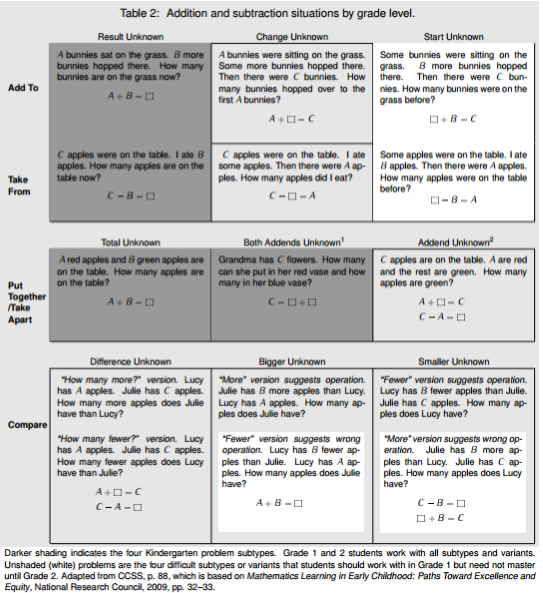
Solving word problems is hard. Word problem keywords seem like a logical solution but this strategy will make solving word problems even more difficult.
Like really, really hard.
In a world where reading comprehension, logical thinking, math computation, and visualization come together, word problems were born.
As teachers, we are interested in doing everything we can to make instruction make sense, come alive and “click” for our students. And, unfortunately, in the interest of the end goal, it can be very easy to try to teach tricks to our students. In the long run, however, this does SUCH a disservice!
Let’s look at the list of commonly taught word problem keywords and match it up to a progression of addition and subtraction word problems from K-2 to see if learning these keywords will serve a student well.
Common Word Problem Keywords
Keywords for addition often include:
add
sum
total
plus
and
in all
altogether
together
more
Subtraction often sounds like:
difference
take away
minus
fewer
less
took
gave away
leftover
difference
First up: Do the keywords hold up in Kindergarten?
CCSS.MATH.CONTENT.K.OA.A.2
Solve addition and subtraction word problems, and add and subtract within 10, e.g., by using objects or drawings to represent the problem.
So, the standards alone here really aren’t enough to determine what word problems look like at this level. To learn about what the standards “look like” you need to look into the progressions document. Have you seen this chart? I know it’s difficult to read, so I have included a link.
Basically, the chart lays out the different type of word problem and then, through the shading, explains which problem types are expected at each grade level.
Back to kindergarten now. The bulk of the problems are put together, take apart, add to and take from problems where the result is the missing piece. Looking at the questions, one by one:
4 bunnies sat on the grass. 5 more bunnies hopped over. How many bunnies are on the grass now?
The keyword indicates addition, addition of 4 + 5 will solve the problem.
10 apples were sitting on the table. I ate 4. How many are on the table now?
No keyword… you could argue that “ate” means take away so that’s subtraction but, in the world of keywords they really offer no help here.
2 green apples and 4 red apples are sitting on the table. How many apples are on the table?
Keyword indicated addition, the addition of 2 + 4 will solve the problem.
Grandma has 10 apples. How many can she put in the red vase and how many can she put in the blue vase?
This question is open-ended and contains no keywords.
Conclusion? In kindergarten, keywords are not misleading, however, they are not helpful in solving all types of word problems.
Do Word Problem Keywords Help in 1st Grade Word Problems?
CCSS.MATH.CONTENT.1.OA.A.1
Use addition and subtraction within 20 to solve word problems involving situations of adding to, taking from, putting together, taking apart, and comparing, with unknowns in all positions, e.g., by using objects, drawings, and equations with a symbol for the unknown number to represent the problem.1
The “1” at the end of this standard is directing you to the chart that describes the problem types. Too bad they didn’t make the same note in the Kindergarten standard…. I digress…
So here you see we have unknowns in all positions in all types of word problems. The only real caveat here is that change problems where the start is missing and comparison problems where the language is intentionally misleading are saved for second.
Let’s go through a few problems:
6 bunnies were sitting on the grass.Some more bunnies hopped there.Then there were 12 bunnies. How many bunnies hopped over to the first 6 bunnies?
Keyword indicates addition. 6 + 12 does NOT solve the problem. A student needs to be quite flexible with situation and solution equations for this key word to make sense.
18 apples were on the table. I ate some apples. Then there were 10 apples. How many apples did I eat?
No keyword. If you were in the camp that said “ate” indicated subtraction before 18-10 will yield the correct answer.
14 apples are on the table. 7 are red and the rest are green. How many apples are green?
No keyword.
Should word problem keywords be used to teach word problems in 2nd grade?
Use addition and subtraction within 100 to solve one- and two-step word problems involving situations of adding to, taking from, putting together, taking apart, and comparing, with unknowns in all positions, e.g., by using drawings and equations with a symbol for the unknown number to represent the problem.1
I am not going to even TOUCH the multi-step nature of word problems at second grade. Obviously, with multiple steps, there may be multiple keywords for a student to sift through.
Here we add in the last 4 type of word problems.
Some bunnies were sitting on the grass. 19 more bunnies hopped there. Then there were 27 bunnies. How many bunnies were on the grass before?
Keyword “more” indicates addition. 19 + 27 will not solve the problem. Addition is appropriate only in a situation equation.
Some apples were on the table. I ate 7 apples. Then there were 45 apples. How many apples were on the table before?
Keyword indicates addition. Addition will NOT solve this problem. Most students, in an attempt to write a situation equation matching addition will write 89 + 63 = L as Julie’s name was written first. The keyword, again, is very misleading.
In fact, in the problem type diagram for the last 2 problems, the descriptions are “fewer suggests wrong operation” and “more suggests wrong operation”.
How To Teach Word Problems WITHOUT Key Words
Related Resources:



Pin For Later:






